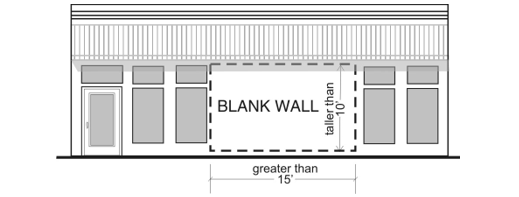19.63.070 Blank wall treatment.
A. Purpose.
1. To avoid untreated blank walls.
2. To retain and enhance the character of Anacortes’s streetscapes.
B. Blank Wall Definition. “Blank wall” means a ground floor wall or portion of a ground floor wall over 10 feet in height and with a horizontal length greater than 15 feet and does not include a transparent window or door.

|
C. Blank Wall Treatment Standards. Untreated blank walls adjacent to a public street, pedestrian-oriented space, common usable open space, or pedestrian pathway are prohibited. Methods to treat blank walls can include:
1. Display windows at least 16 inches of depth to allow for changeable displays. Tack-on display cases (see Figure 19.63.070(C) below) do not qualify as a blank wall treatment.
2. Landscape planting bed at least five feet wide or a raised planter bed at least two feet high and three feet wide in front of the wall with planting materials that are sufficient to obscure or screen at least 60 percent of the wall’s surface within three years.
3. Installing a vertical trellis in front of the wall with climbing vines or plant materials.
4. Installing a mural as approved by the Director.
5. Special building detailing that adds visual interest at a pedestrian scale. Such detailing must use a variety of surfaces; monotonous designs will not meet the purpose of the standards.
For large visible blank walls, a variety of treatments may be required to meet the purpose of the standards.
DEPARTURES will be considered, provided the entire facade composition meets the intent of the standards for the context of the wall (e.g., walls along pathway corridors connecting parking areas to building entries might be granted more flexibility than street facades).

Acceptable and unacceptable blank wall treatments. Note in the far right example, the display cases don’t meet the 16'' depth requirement, nor does the design meet the purpose of the standards. |
(Ord. 3040 § 2 (Att. A), 2019)